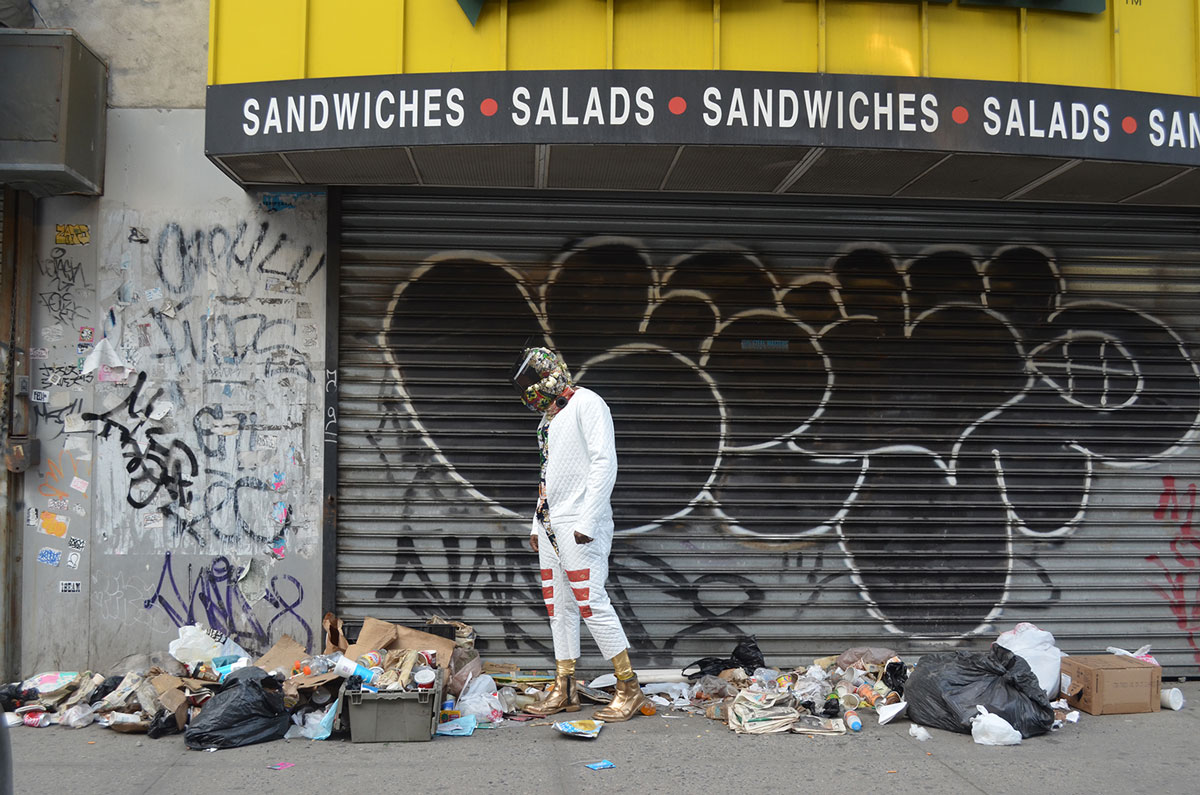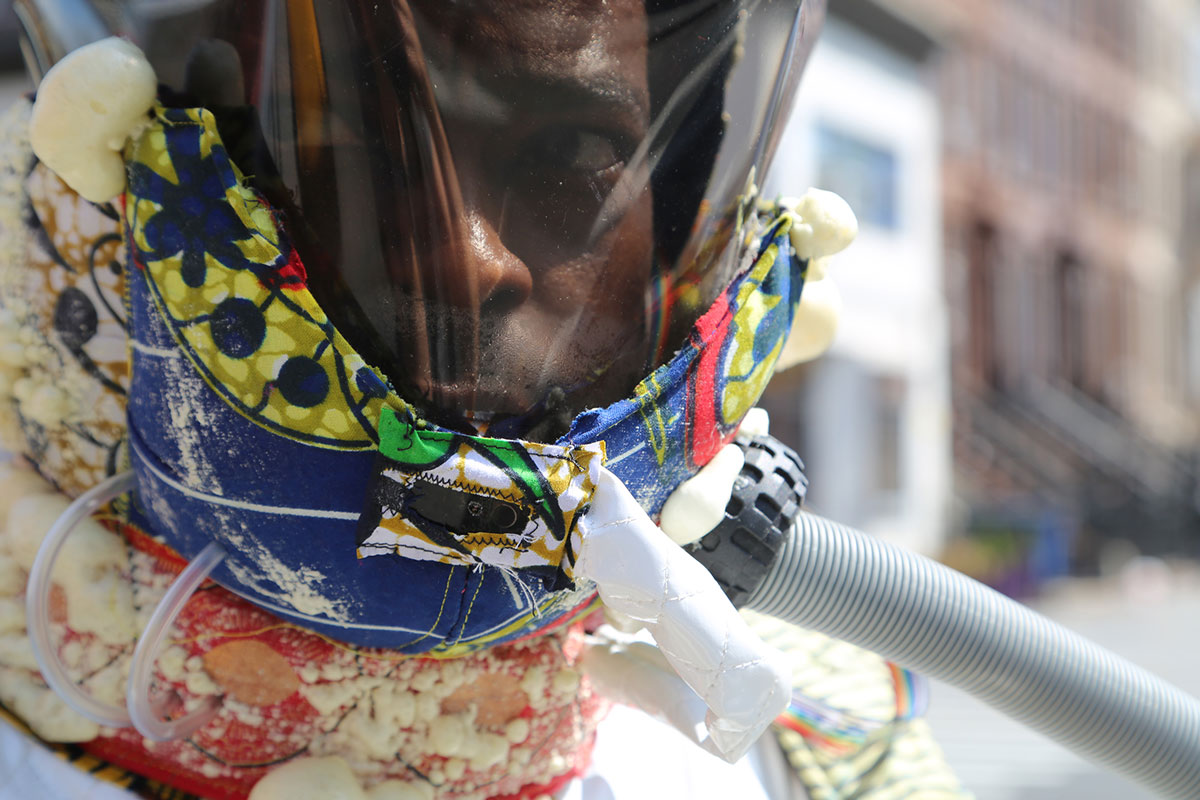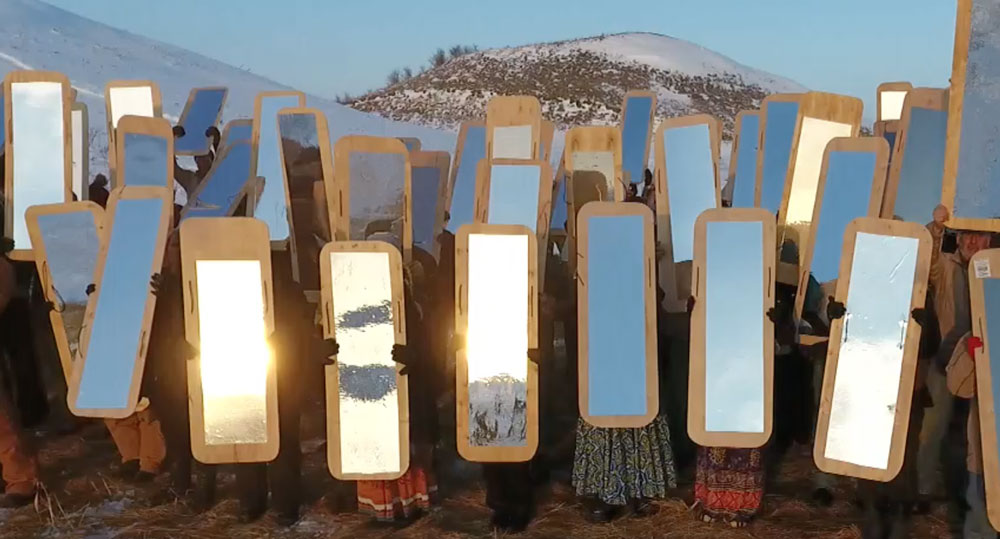In arts and social change work, we talk about the importance of being able to imagine a future that is better — more just — than the world we live in today. But often the struggle is a more existential one: imagining a future where one’s community or culture exists at all.
Last year I had the great pleasure of hearing a talk by artist and interactive designer Ayodamola Tanimowo Okunseinde (Ayo). “Blackness,” he told the gathered crowd at the URBAN conference in New York City, “is being removed from the future.” This removal, he explained, is partly physical: black bodies are being violently removed from the future through police killings, mass incarceration, and other systems of racial oppression.
This removal is also representational. Black people are either misrepresented or completely unrepresented in popular visions of the future. Mainstream science fiction, on the page and on the screen, is dominated by white authors and their white characters. This lack of representation of People of Color is not only a question of equity. What happens when people spend their lives being fed visions of the future that don’t include them? What does that do to their self-perceptions? To their their ability to plan for the future? What does it do to our collective capacity to imagine — and enact — something different?
In response, Ayo has transformed himself into an Afronaut. He walks the streets of New York as Dr. Tanimowo, a time traveler from a future where African diasporic peoples and cultures are well represented. His outfit — part space suit, part Yoruba masquerade — blends space-age materials with West African-patterned fabrics. As he journeys through our present time, Dr. Tanimowo interacts with passers-by. For a moment, they are presented with an alternative and potentially liberating vision of the future. As Ayo explains, these travels are “a ritualistic rite, or a ritual that’s actually creating the future itself.”1

Ayo is also encouraging others to imagine Black futures. With fellow artist Salome Osega, Ayo runs workshops where community members can become futuristic archeologists. Participants “uncover” artifacts from the future through design, and many of those designs are then built, here in the present. Ayo and Osega co-founded the Iyapo Repository to hold and display these artifacts: pills that teach African American history, a wetsuit that helps alleviate the cultural trauma of the Atlantic Slave Trade, a necklace that senses “bad vibes” by warning the user when they are in a location where there has been a police shooting.
Ayo’s interactive design work is rooted in, among other things, Afrofuturism. Coined in the early 90’s, the term Afrofuturism was an attempt to delineate a particular tradition of African American futuristic and technological imagination — a tradition embodied in the speculative fiction of Octavia Butler and Samuel Delaney, the music of Sun Ra and P-Funk, and the visual art of Basquiat and Rammellzee, among others.2 The concept was further developed by a group of writers and critics on Alondra Nelson’s Afrofuturism listserv, and came to encompass a much larger arena of cultural production. In the words of Nelson, Afrofuturism is
“a critical perspective that opens up inquiry into the many overlaps between technoculture and black diasporic histories. AfroFuturism looks across popular culture…to find models of expression that transform spaces of alienation into novel forms of creative potential. In the process it reclaims theorizing about the future.” 3
Afrofuturist aesthetics seem to have made a resurgence in recent years through the work of popular artists like Beyoncé and Janelle Monáe. Meanwhile, Afrofuturism has helped to inspire other art and scholarship, like the Indigenous Futurism of Wendy Redstar and the Chican@futurism of Marion C. Martinez. These and other artists are directly challenging popular discourses that associate progress, technology, innovation, and the future itself with whiteness.
Unlike other “futurist” movements, Afrofuturism and its cousins are neither a break with the past nor a fetishization of the new. They are deeply rooted in history. They offer what Nelson calls “past-future visions.” Like Ayo’s high tech space suit, with its traditional West African elements, these visions “insist that who we’ve been and where we’ve traveled is always an integral component of who we can become.”4 They forefront continuity rather than rupture, overlaying past, present, and future. As the Afrofuturist Affair writes, this kind of time-bending is not new to Communities of Color.
“Whether you call it mythology, ghost stories, cosmology, parable, folktale, sci-fi, religious tale, or fantasy, people of color have always contemplated their origins in the same breath that they anticipated the fate of humankind.”5
Organizers and activists also seem to be taking an increased interest in the future. In 2015, the Movement for Black Lives and Huffington Post launched an annual celebration of Black Futures Month, a remixing of Black History Month that calls on people to “seize the opportunity to change the course of history by shaping our future.” That same year, AK press put out Octavia’s Brood, an engrossing collection of SF short stories written by activists and organizers. Of course, social justice organizing is often driven by a vision of a future better than the one we live in. But something deeper is going on here: a recognition that the future, despite its intangibility, is directly impacting us today.
Take US politics. The election campaign that lifted 45 to the presidency was premised largely on fear of the future. In his speeches and tweets, 45 conjured an imagined future in which the US is overrun by “terrorists,” “rapists,” and “criminals” from across our borders. In this racist, dystopian future, white people sacrifice power and safety amid hostile aliens. This future is not real in any concrete sense. And yet, it affects the present in multiple ways — increasing support for racist policies, emboldening white supremacist organizations, and igniting hate crimes, just to name a few. In this sense, the future is what Andrew Baldwin calls a “permanent virtuality,” unreal and yet ever-present.6
Scholars have taken to using the term futurity to explore these interactions between past, present, and future. From my reading, futurity refers to three main dynamics:
- The ways that the future is defined (or “rendered knowable”) through practices such as prediction, projection, imagination, prefiguration, and prophecy;7
- The ways that the future impacts the present, for example through fear, hope, preparation, and preemption;8and
- The ways that our thoughts and actions in reference to the future make some futures more likely, and others less likely, to come about.9
In his book Cruising Utopia, José Esteban Muñoz proposes that queerness is a kind of futurity. “Queerness,” he writes in the book’s introduction, “is not yet here…Put another way, we are not yet queer.”10 Instead, he explains, queerness is an ideal. It is a utopian vision that can help us to see beyond our everyday restrictions toward new possibilities. We cannot touch queerness with our hands, or claim to fully know what it is. We can, however, get glimpses of it, particularly in the realm of cultural production. Through poems, plays, visual art, dance, and other types of performance, artists can step away from what Munoz calls “straight time” — that sense that the present is natural and enduring — to suggest alternative futurities.
The concept of futurity seems to have been most fully developed by Indigenous scholars and activists. As Native scholars have shown, settler colonialism (the kind of colonialism we have in the US, where the colonizer comes to stay) involves an ongoing project of erasure and replacement.11 After all, settler claims to the land in the Americas, the Pacific Islands, and elsewhere only make sense if the original inhabitants are gone. And, despite centuries of genocide, they are not.
Part of the modern settler project, then, is to erase Indigenous peoples — if not physically (through policies that deny land, health care, etc.) or culturally (through blood quantum tests or the forced removal of children), then at least from popular consciousness. Movies, television shows, school curricula, political speeches, news reports, and other media relegate “the Indian” to our past — a sad chapter in history, perhaps, but nothing to concern ourselves with as we dream of the future. By erasing Indigenous people from the present and the future, these discourses advance the cause of what scholars like Eve Tuck call settler futurity. In other words, these discourses are premised on, and help to bring about, a future of endless settler dominance over the land and all that is on/of it.12
Indigenous communities, though, are (re)claiming the future — opening up space for indigenous futurities to flourish.13 To advance indigenous futurity is to assert, and takes steps to make possible, futures outside of settler colonialism. We can get glimpses of indigenous futurities in the social movement organizing of Idle No More, among the water protectors at Standing Rock, in the Indigenous media production of Indian and Cowboy, and in everyday assertions of Native culture and sovereignty. Noelani Goodyear-Kaʻōpua writes that, although they are often framed as relics of the past, Indigenous communities are actually at the front lines of the struggle to protect the future. Writing about Native Hawaiian efforts to defend cultural and natural resources, she notes that “When colonial discourses frame blockades at Newcastle or on Mauna a Wākea as obstructions on a march to “the future,” they miss the ways this kind of activism is actually protecting the possibilities of multiple futures.”14
This work is rooted deeply in Indigenous cultural practices and epistemologies, which, according to Hawaiian activist and blogger Bryan Kamaoli Kuwada, have always attended to both the past and the future.
“The future is a realm we have inhabited for thousands of years. You cannot do otherwise when you rely on the land and sea to survive. All of our gathering practices and agricultural techniques, the patterned mat of loʻi kalo, the breath passing in and out of the loko iʻa, the Kū and Hina of picking plants are predicated on looking ahead. This ensures that the land is productive into the future, that the sea will still be abundant into the future, and that our people will still thrive into the future.”15
A Final Note
When I was coming up in the world of social justice arts and organizing, much of the focus was on history. We studied how injustices like racism and colonialism were historically constructed. We learned how histories of activism and rebellion had been hidden, rewritten, and co-opted to reinforce the right of those in power to rule. We supported youth as they came to see themselves as part of long social movement traditions. This focus on the past was, and is, terribly important.
At the same time, I am energized by what I see as a growing emphasis on the future as an arena of active struggle. Because that’s certainly how those in power see it. Wall street traders are gambling on our futures. Tech companies are redesigning our futures. Hollywood is whitewashing our futures. And all the while, unfettered capitalism is foreclosing so many healthy futures for this planet. Imagining alternative futures is, quite literally, a matter of life and death.
The struggle for futurity is on, and as artists and cultural workers we are right in the middle of it, whether we know it or not. It’s time to accept the invitation of Bryan Kamaoli Kuwada: “We live in the future,” he writes. “Come join us.”16
References
1. The Mothers Nature, Ayo the Afronaut meets World
2. Mark Dery, Black to the Future, in Flame Wars: The Discourse of Cyberculture
3. Alondra Nelson, AfroFuturism: Past-Future Visions, ColorLines Magazine
4. ibid
5. Afrofuturist Affair, About – Afrofuturist Affair, http://www.afrofuturistaffair.com/about-afrofuturist-affair
6. Andrew Baldwin, Whiteness and futurity: Towards a research agenda, Progress in Human Geography
7. ibid
8. ibid
9. Eve Tuck, Marcia McKenzie & Kate McCoy, Land education: Indigenous, post-colonial, and decolonizing perspectives on place and environmental education research, Environmental Education Research.
10. José Esteban Muñoz, Cruising Utopia: The Then and There of Queer Futurity
11. Eve Tuck & Rubén Gaztambide-Fernández, Curriculum, Replacement, and Settler Futurity, Journal of Curriculum Theorizing; Patrick Wolfe, Settler colonialism and the elimination of the native, Journal of Genocide Research; Adam Barker, Already Occupied: Indigenous Peoples, Settler Colonialism and the Occupy Movements in North America, Social Movement Studies
12. Eve Tuck & Rubén Gaztambide-Fernández, Curriculum, Replacement, and Settler Futurity, Journal of Curriculum Theorizing; Eve Tuck & K. Wayne Yang, Decolonization is Not a Metaphor, Decolonization: Indigeneity, Education, & Society.
13. ibid
14. Noelani Goodyear-Kaʻōpua, Protectors of the Future, Not Protestors of the Past: Indigenous Pacific Activism and Mauna a Wākea, South Atlantic Quarterly
15. Kamaoli Kuwada, We Live in the Future. Come Join Us
16. ibid



